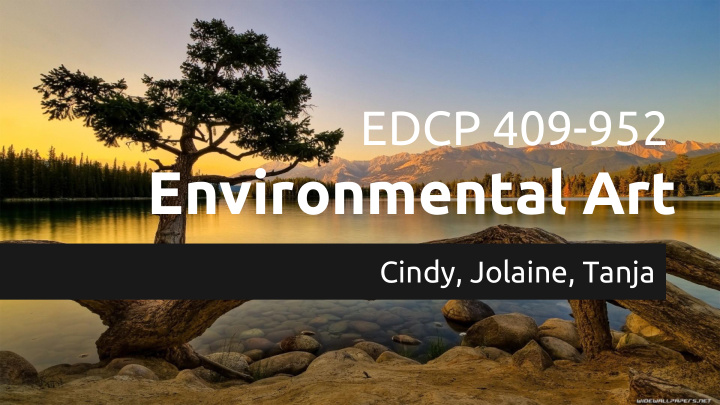



EDCP 409-952 Environmental Art Cindy, Jolaine, Tanja
“We learn by doing.” (John Dewey) “All senses are needed in the learning process.” (Viktor Lowenfeld) “Learning occurs properly in an active and stimulating environment.” (Jerome Bruner)
What is Environmental Art? The term “Environmental Art” is used as an umbrella term and in a variety of different contexts, including: Art describing the natural world ● Celebrating personal engagement with the natural world ● ● Land Art/Earth Art Ecological Art: ● Educating people about the natural world ○ Intervening/restoring the natural world ○
Land Art/Earth Art Began in the late 1960s and early 1970s ● ● Artistic process against the perceived artificiality and commercialization of art at the end of the 1960s in America Art form created in nature using natural materials ● Soil, rock, logs, branches, leaves, water ● ● Concrete, metal, asphalt, mineral pigments Sculptures are part of the landscape ● Often earth-moving equipment is used ● Often left to change or erode under natural conditions (ephemeral) ● ● Site specific sculpture
Ecological Art Art practice that embraces an ethic or social justice in both its content ● and form/materials Artists, scientists, philosophers, activists ● ● Focused on systems and interrelationships within our environment: Geographic, political, biological, cultural ○ Creates awareness, stimulates dialogue, changes human behaviour ● towards other species, encourages long term respect for the natural systems we coexist with Socially engaged, activist, community-based restorative or ● interventionist art
Place-based Education Sometimes called a pedagogy of place, community-based education, or ● experiential education ● Promotes learning that is rooted in what is local (history, environment, culture, economy, and art) Students often lose their “sense of place” through focusing too ● exclusively on global issues (not to say that this isn’t important) but students should first have a grounding in the history, culture, and ecology of their surrounding environment Hands-on, project-based, and always related to real world experiences ● Built around sustainable community development and mindful living ●
Ethical Concerns What is acceptable?
Lesson Plan Collaborative Outdoor Living Space
Rationale ● To raise students’ awareness of environmental issues such as sustainability and human impact on the environment To introduce students to a range of artists who create inspirational ● environmental masterpieces ● For students to create a collaborative outdoor living space sculptures using only natural materials that will ultimately be returned to their natural state, leaving no trace of the artwork’s existence
Learning Objectives ● Students will create a living space sculpture using natural materials Students will become familiar with artists who create environmental art ● and the messages they are trying to convey Students will learn and use vocabulary, image development and design ● strategies, stylistic elements, and the principles of art and design Students will use critical thinking and problem solving to create their ● living space outdoor sculptures Students will explore the relationships between art, audience, and ● location
Prescribed Learning Outcomes Analyze ethical factors affecting the production of 2D and 3D images ● Analyze how particular elements and principles are used to create meaning and effect in 2D ● and 3D images Evaluate roles that visual arts have in reflecting, sustaining, and challenging beliefs and ● traditions Develop knowledge and use of visual elements and principles of art and design as they ● apply to sculpture Develop knowledge and use of processes and techniques for sculpture ● Demonstrate considerations for venue, audience, and purpose unique to sculpture ● Provide documentation of development process (e.g., portfolio of process drawings to ● accompany a finished work, using sketchbook to plan design process) Analyze sculpture artworks from a variety of contexts and artists ● Develop vocabulary related to sculpture ●
Lesson 1. What is “environmental art”? (brainstorm and write on the board) 2. Introduce environmental art and artists: a. Discuss elements and principles of art and design b. Discuss current environmental concerns and how they could relate to their project c. Discuss ethics of working with nature d. Interaction/audience
Activity 1. Discuss project requirements: Create collaborative outdoor artwork a. Materials must be found, natural elements only i. No plucking from live plants! b. Use at least 3 different natural elements c. May use natural rope/string d. Include at least 1 design element (repetition, pattern, space, scale, harmony) 2. Possible extension of working time 3. Clean up of working area, put materials away 4. Documentation of work required (photographs) 5. Gallery walk: Discussion of peer artwork using learned vocabulary 6. Closing: Recap what the students learned
Adaptations, Modifications, Extensions Adaptations & Modifications: Natural materials may be brought into the classroom ● ● Model academic language, checking for student understanding Providing visuals to give examples ● Vocabulary list ● Extensions: ● Creating an ad to “sell” the living space sculpture Write an artist statement to talk about the piece ● Document the process of decay (film/photography) ●
Collaborative Outdoor Living Space Our Example
Recommend
More recommend